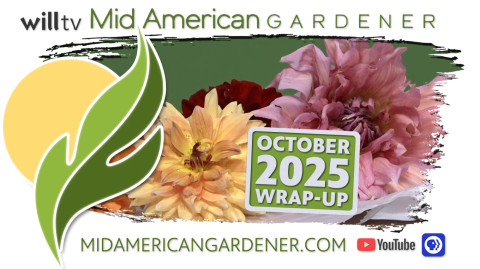Lazy Gardening, Big purple Tomatoes & Harvesting Nasturtium Seeds
This episode of Mid-American Gardener features host Tinisha Spain, and guests Jennifer Nelson and Kay Carnes. The trio dives straight into show-and-tell, starting with Jen’s “ cottage garden” blooms—cosmos, alyssum, and four o’clocks—all volunteer plants that reseed themselves each year. Jen explains the beauty of letting plants behave naturally, embracing “chaos gardening” for its charm and simplicity.
Kay follows with a striking example of garden longevity—a massive, 20-year-old hardy hibiscus that blooms beautifully every summer. She shares how the plant goes dormant in the winter, only to come back as a seven-foot-tall stunner each year without needing fertilizer or compost. It thrives in full sun and is a prime example of low-effort, high-reward gardening.
Then we talk about tomatoes—specifically, Jennifer’s purple tomato plants. Despite some blemishes from stink bug feeding, the tomatoes are good to eat. Jen explains how stink bugs pierce the skin with needle-like mouths, causing light-colored spots. Fortunately, it’s only cosmetic damage.
Tinisha, brings in dried black opal basil and parsley, asking for storage advice. Kay recommends keeping dried herbs in jars (recycled or Mason) in dark areas and possibly grinding them into finer textures.
Next, Tinisha brings in green nasturtium seeds and learns from Jen that they were likely picked too early. Nasturtium seeds should be brown and dry before harvesting to ensure successful germination. However, Jen shares a clever culinary twist—green seeds can be pickled and used like capers, as nasturtiums are entirely edible and often used in gourmet cooking.
Weather-related challenges get attention too. Kay and Jen talk about how strange spring weather affected planting schedules and how late-start gardens (whether intentional or not) can actually benefit from avoiding peak insect activity. Jen shares her experience with staggered planting and succession gardening as an effective pest management strategy.
Questions round out the episode. One viewer asks about curled pepper leaves despite still getting fruit. The consensus? It could be environmental stress or even seed-borne fungal issues, as Jen shares a past experience traced back to her pepper plant supplier.
Deadheading flowers like daisies, Black Eyed Susans, and bee balm is also covered, with Kay and Jen both recommending it to improve plant appearance and reduce disease risk.



